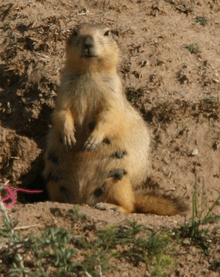Long-tailed marmot
| Long-tailed marmot | |
|---|---|
 | |
| Scientific classification | |
| Kingdom: | Animalia |
| Phylum: | Chordata |
| Class: | Mammalia |
| Order: | Rodentia |
| Family: | Sciuridae |
| Genus: | Marmota |
| Subgenus: | Marmota |
| Species: | M. caudata |
| Binomial name | |
| Marmota caudata (Geoffroy, 1844) | |
The long-tailed marmot or golden marmot (Marmota caudata) is a species of marmot in the family Sciuridae.[2] Found in mountainous regions in Afghanistan, Kyrgyzstan, Pakistan, Tajikistan, India and China, its altitudinal range is from 3,200 to 4,850 metres (10,500 to 15,910 ft) above sea level. Its typical habitat is rough grassland and alpine meadows, often among rocks where dwarf junipers grow. Although the population trend is unknown, It has a wide range and large total population size, and the International Union for Conservation of Nature has assessed its conservation status as being of "least concern".[1]
Description
The long-tailed marmot is a large, sturdy rodent weighing up to 9 kg (20 lb). The eyes are close to the top of the rather-flattened head, the ears are small and the neck is short. The forelegs are longer than the hind legs and the tail is longer than in other species of marmot.[3]
Biology
The long-tailed marmot usually forms monogamous relationships but lives in larger social groups, with up to seven adults sharing a single home range. These individuals are likely to be related to each other with young adults normally only dispersing after they have become fully grown at three or more years of age. Adult immigrants are tolerated in the group but only a single adult female normally lactates and rears young in any one season.[4]
Home ranges of the long-tailed marmot average about three hectares and contain about three burrow systems (range one to six). In a chamber in one of these burrows the marmots hibernate from about September to April or May, a period during which the ground is covered with snow for much of the time.[4] Different burrows may be used for hibernation in different years. Mating occurs in late April and early May and may take place underground before the marmots emerge from the burrow after the winter. The gestation period is about four and a half weeks and the litter of about four pups emerges from the nest at about six weeks of age. Only about half of the pups survive the summer, some being consumed by predators and others being killed by adult males joining the group. Most adults survive the hibernation period but a rather higher proportion of juveniles die during their first winter. Females do not usually breed as three-year-olds but wait till the following year.[4]
The long-tailed marmot is diurnal and feeds on plant material. It is most active in the morning when about forty percent of the time is spent foraging. After emerging from the burrow, the marmots spread out and do not forage as a group. Food is either collected from the ground by the mouth or plucked from taller plants. Between bouts of foraging, a marmot sometimes stands on its back legs and surveys its surroundings. Group members communicate with each other, emitting complex alarm calls when predators are spotted. They also react to the alarm calls of neighbouring groups. Predators of the long-tailed marmot include the red fox (Vulpes vulpes), the grey wolf (Canis lupus), the snow leopard (Panthera uncia), the golden eagle (Aquila chrysaetos) and possibly the bearded vulture (Gypaetus barbatus).[5]
References
- 1 2 Molur, S. (2008). "Marmota caudata". IUCN Red List of Threatened Species. Version 2014.2. International Union for Conservation of Nature. Retrieved 29 October 2014.
- ↑ Thorington, R.W., Jr.; Hoffman, R.S. (2005). "Family Sciuridae". In Wilson, D.E.; Reeder, D.M. Mammal Species of the World: A Taxonomic and Geographic Reference (3rd ed.). Johns Hopkins University Press. p. 801. ISBN 978-0-8018-8221-0. OCLC 62265494.
- ↑ DeWeerd, B. (2003). "Marmota caudata". Animal Diversity Web. University of Michigan. Retrieved 2014-10-21.
- 1 2 3 Blumstein, Daniel T.; Arnold, Walter (1998). "Ecology and Social Behavior of Golden Marmots (Marmota caudata aurea)". Journal of Mammalogy. 73 (3): 873–886. doi:10.2307/1383095. JSTOR 1383095.
- ↑ Blumstein, Daniel T. (1996). "How Much Does Social Group Size Influence Golden Marmot Vigilance?". Behaviour. 133 (15/16): 1133–1151. doi:10.1163/156853996x00332. JSTOR 4535417.
